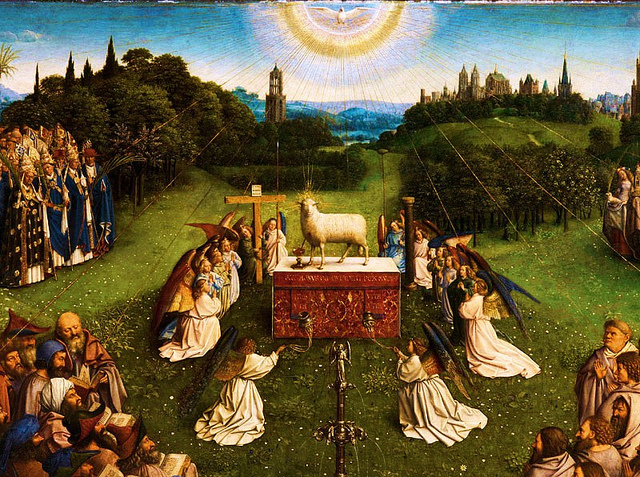100 Greatest Painters Artists Alphabetically Artists by Country Artists by Century Artists by Movement
Search:: Artists Alphabetically Artists by Country Artists by Century Artists by Movement
Hubert van Eyck also known as Magister Hubertus1385 – 1426
Northern Renaissance Early Netherlandish, Antwerp School Painter
Stylistically influenced by the following
painter - Rogier
van der Weyden

Ghent Altarpiece or Adoration of the Mystic Lamb by Hubert van Eyck and Jan van Eyck c.1434 Oil on wooden panel at the National Gallery, London
When Hubert van Eyck along with his brother Jan, arrived in Bruges at the beginning of the fifteenth century they revolutionized painting with their refinements to oil painting formulas and techniques. During the time of Hubert van Eyck the culture and the art of painting, was becoming more important to the people of Flanders. Manuscript illuminators laboring in the scriptoriums of the great monastic houses were the first artists of the region. Painters such as Hubert were greatly influenced by those creative monks. Flemish painting begins with the divine splendour of brothers, Hubert van Eyck and Jan van Eyck.During his lifetime Hubert van Eyck was the most celebrated painter of the brothers. His visually stimulating and deeply thoughtful painting style inspired generations of artists. The Ghent altar-piece was began by Hubert and finished by Jan. Hubert painted from real life in natural light. He gave his compositions true perspective and depicted realistic background landscapes. His figures are rendered in realistic detail with remarkable technical precision.
Important Words, People and Principal Phrases, Characteristics Related to the Northern Renaissance Art Movement - allegorical painting, rebirth, invention of oil painting, Hieronymus Bosch, Limbourg Brothers, Desiderius Erasmus, Robert Campin, Jan Van Eyck, Jean Fouquet, Albrecht Dürer, Johannes Gutenberg, Johann Reuchlin, Martin Luther, rise of the merchant class, world landscape, Low Countries, Protestant Reformation, Calvinisim, glazing, impasto, scriptorium, illuminator, invention of the printing press, woodcuts, engravings, Antwerp School, Guild of Saint Luke, commerce, Flemish School, Northern Europe, Flanders, Bruges, renewed interest in classical learning, mythological scenes, genre painting, landscapes, portraits, moralizing overtones, human vices, lust, paradise, spirituality, piousness, living a simple life, reform, Human Reasoning, tradesmen at work, idyllic scenes of peasants, playing games, feasting, linear perspective, \Heliocentric Theory, humour, satire, spiritually significant, illuminated manuscript, idealized biblical themes, scriptorium, emotion, illuminator, iconoclast, Age of Discovery, Virgin and Child, axonometric drawing, curiosity about the natural world, realistic use of colours and light, Old Testament stories, Gospel parables, The Blackdeath, Christian symbolism
☼☼☼☼☼
If you feel you have worthwhile information you would like to contribute we would love to hear from you. We collect essential biographical information and artist quotes from folks all over the globe and appreciate your participation. When submitting please, if possible, site the source and provide English translation. Email to historyofpainter@gmail.com
© HistoryofPainters.com 2017
If you like this page you are welcome to link to it, with our thanks.
Popular Questions About Renaissance Art History
What is the difference between Italian Renaissance art and Northern Renaissance art?
How did the Black Death impact European art history?
How did the Inquisition impact European art history?
What was the influence of the Medici Academy on Renaissance painters?
What was the Bonfire of the Vanities?
Who were the greatest painters of the Renaissance?